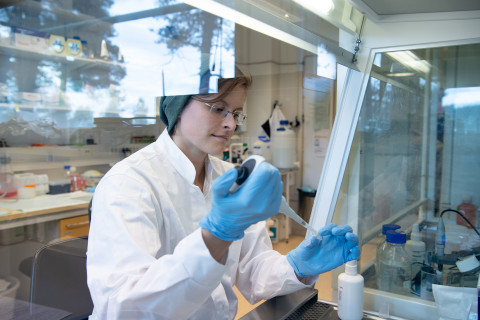Repeat expansion in the C9orf72 gene is a major cause of frontotemporal lobar degeneration (FTLD) and amyotrophic lateral sclerosis (ALS). A new study by the researchers of University of Eastern Finland provides novel insights into the previously unknown effects of the C9orf72 repeat expansion on microglial cells. The results imply that microglia may be less vulnerable than neurons to its harmful effects.
Microglia are important new targets to study the effects of the C9orf72 repeat expansion
Hexanucleotide repeat expansion in the C9orf72 gene is the most common genetic cause of both FTLD and ALS. Notably, the C9orf72 expansion is exceptionally prevalent among Finnish FTLD and ALS patients. So far, neurons have been the primary subject of interest in most studies on neurodegenerative diseases, but the contribution of other brain cells, such as microglia, to disease pathogenesis has remained largely unexplored. The C9orf72 gene is highly expressed in microglia, key immune cells of the brain, and the repeat expansion may lead to altered C9orf72 function. Thus, more research should be focused on clarifying the role of microglia in neurodegeneration in FTLD and ALS. The importance of investigating microglia is further supported by recent genetic studies, which indicate that many genes increasing the risk for neurodegenerative diseases, including FTLD and ALS, are expressed by microglia. A recent study from the University of Eastern Finland takes a novel focus specifically on microglia in investigating the impact of the C9orf72 repeat expansion.
Mouse microglial cells show similar C9orf72 expansion-associated pathological changes to neurons but no signs of toxicity or altered function
In the new study, a mouse microglial cell model expressing the C9orf72 repeat expansion was generated. Similar to previous studies in neurons, these microglial cells were found to express abnormal proteins specifically generated from the C9orf72 repeat expansion termed dipeptide repeat (DPR) proteins. Increased cytoplasmic TDP-43 protein was also detected in the microglial cells in the present study. Aberrant cytoplasmic accumulation of TDP-43, which normally resides in the nucleus, is known to take place in the neurons of patients carrying the C9orf72 repeat expansion. Interestingly, in contrast to neurons, the present study did not find accumulation of the pathological nuclear RNA foci in microglial cells expressing the C9orf72 repeat expansion. Whereas accumulation of the DPR and TDP-43 proteins has previously been shown to be toxic for neurons, the microglia did not show signs of cell toxicity.
Microglia are immune cells, which constantly survey their environment and remove dead cells, dysfunctional synapses, or infectious agents through a process termed phagocytosis. Microglia also respond to different inflammatory stimuli by secreting both pro- and anti-inflammatory factors that may boost or alleviate inflammation. Expression of the C9orf72 repeat expansion in mouse microglial cells did not appear to interfere with their phagocytic capacity or capability to respond to an inflammatory stimulus, suggesting that the microglia remain functional despite the presence of the accumulated DPR or TDP-43 proteins.
Previous studies in C9orf72 knockout mice have indicated alterations in the lysosomes of the microglia, which might reflect potentially compromised lysosomal or autophagosomal degradation in the cells. No evident changes in the lysosomes or autophagosomal function were found in the mouse microglial cells expressing the C9orf72 repeat expansion. Moreover, a recently reported change in microglial RNA expression profile, which may associate with Alzheimer’s disease and ALS and lead to a microglial phenotype termed disease-associated microglia (DAM), was not detectable in the microglia expressing the C9orf72 repeat expansion in the present study.
In summary, the results in the current mouse microglial cell model suggest that, despite the accumulation of the pathological C9orf72 repeat expansion-associated DPR and TDP-43 proteins, microglia remain viable and functional. These data imply that microglia may be less vulnerable to the harmful effects of the C9orf72 repeat expansion than neurons.
The study, openly accessible in Frontiers of Neurology, was carried out in the Molecular Neurodegeneration research group of Research Director, Adjunct Professor Annakaisa Haapasalo at the A.I. Virtanen Institute for Molecular Sciences. The main author of the article, MSc Hannah Rostalski is an Early Stage Researcher in the GenomMed Doctoral Programme at UEF. Understanding how the C9orf72 repeat expansion affects microglial cell molecular pathology and function is one of the central research interests of the Haapasalo group and the main focus of Hannah Rostalski’s PhD project.
The present study is the first one to introduce the C9orf72 repeat expansion into microglial cells and to examine its consequences to microglial function and molecular pathological changes. According to Haapasalo and Rostalski, the study provides an excellent starting point for further exploration of the impact of C9orf72 repeat expansion in microglia. However, future studies investigating the long-term effects of the C9orf72 repeat expansion on microglial cells requires other model systems, including in vivo mouse brain microglia or human induced pluripotent stem cell-derived microglia from patients who carry the C9orf72 repeat expansion. Such studies are currently ongoing in Haapasalo’s research group.
The now published research is supported by Academy of Finland, Yrjö Jahnsson Foundation, Päivikki and Sakari Sohlberg Foundation, and ALS tutkimuksen tuki ry. The work is also part of the research activities of the Finnish FTD Research Network (FinFTD). The publication is part of a project that has received funding from the European Union's Horizon 2020 research and innovation programme under the Marie Skłodowska-Curie grant agreement No 740264.
More information:
Early Stage Researcher Hannah Rostalski, A.I. Virtanen Institute for Molecular Sciences, University of Eastern Finland
Research Director, Adjunct Professor Annakaisa Haapasalo, A.I. Virtanen Institute for Molecular Sciences, University of Eastern Finland https://uefconnect.uef.fi/en/person/annakaisa.haapasalo/
The open access article:
Rostalski H, Hietanen T, Leskelä S, Behánová A, Abdollahzadeh A, Wittrahm R, Mäkinen P, Huber N, Hoffmann D, Solje E, Remes AM, Natunen T, Takalo M, Tohka J, Hiltunen M, Haapasalo A. BV-2 microglial cells overexpressing C9orf72 hexanucleotide repeat expansion produce DPR proteins and show normal functionality but no RNA foci. Front. Neurol., 06 October 2020 https://doi.org/10.3389/fneur.2020.550140


